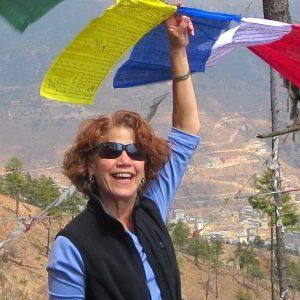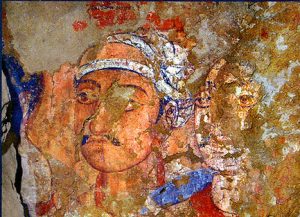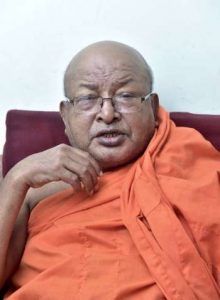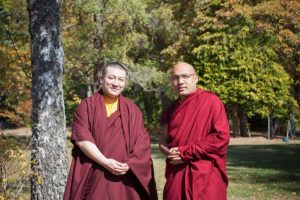My right hand floats up like a tendril reaching heavenward and my left extends toward the earth as I move my dancing body through space, circumscribing the borders of my mandala palace. Then I spin myself into the center as the noble goddess Tara. With the narrative mudras and fluid poses of the sacred dance form charya nritya, I depict my divine qualities. Repeatedly, to the recurring refrain of the accompanying song, my left hand forms the signature abhaya mudra of fearlessness as my right gestures supreme generosity indicated by the varada mudra and I feel Tara awaken in my body.
In the Newar (the indigenous people and culture of the Kathmandu Valley) Vajrayana tradition, dance is a spiritual discipline called charya nritya. The charya nritya dances coupled with the charya-giti (Sanskrit songs of praise) were, until recently, secret practices known only to the priestly, non-monastic caste of vajracharyas (masters of the Vajrayana tradition) in Nepal. My inspiring teacher of this body-mind practice is Prajwal Ratna Vajracharya, a 35th generation Vajrayana priest and foremost lineage holder of this thousand-year-old Buddhist tradition. He has been teaching charya nritya and other Newar Vajrayana arts and practices at his base in Portland, Oregon, the Nritya Mandala Mahavihara (Dance Mandala Temple and Study Center), as well as internationally. And since the onset of the pandemic, Prajwal, as he is known, has taught online and now in hybrid format through Yangchenma Arts & Music. The Portland vihara, now in its 13th year, was the first Newar Buddhist temple to be established in the last 350 years and outside of Nepal.


Prajwal explains that Newar Buddhists chronicle their long history in the Kathmandu Valley to times preceding the historical Buddha, and acknowledge the presence of previous buddhas in their past. The foundational Newar text, the Swayambu Purana, recounts this and tells how the valley was at one time a magnificent lotus lake surrounded by a ring of mountains. The great Bodhisattva of Wisdom Manjushri is said to have visited the valley and perceived its potential as an ideal site for human settlement. He drew his flaming sword of wisdom and sliced a cleft in the underlying bed, draining the waters and making the location suitable for human civilization. A rich and vibrant world of Buddhist life and culture sprouted in the valley, also called the Nepal Mandala.
The vajracharyas trace their lineage to the 10th century tantric master Shantasri, also known as Shantikar Acharya. According to Buddhist scholar and authority on Newar Buddhism Dr. Miranda Shaw, Shantasri composed the first charya song after having a vision of the Bodhisattva Manjushri. The charya dances serve as an embodied support for deity yoga as well as a component of Newar Buddhist devotion and ritual. In deity yoga, the meditator unites with a deity by invoking, visualizing, and absorbing into oneself the divine archetype in a process of integrating its supreme qualities. The dances are performed during the section of a sadhana (meditation practice associated with a particular deity) that invokes and describes the deity. In Newar Buddhism, every sadhana includes a dance component.
Prajwal frequently reminds his students: “Without dancing and singing, there is no possibility of enlightenment.” Each dance─through mudras, full-body postures, energy-directed movements, symbolic clothing and ornaments, and the accompanying charya-giti─invites and evokes a different tantric deity. Performing and visualizing the deity, the practitioner integrates and embodies its divine presence.
In Vajrayana Buddhism, the physical body is considered a sacred mandala─a microcosm of the greater universe. Through charya singing and dancing, the entire body mandala is animated in a process of self-transformation. The dance movements and vocalizations are conceived to prime the body for the energetic flow of awareness and compassion. For example, chanting mantras produces sound vibrations that are intended to open and purify the chakras and channels (subtle energy centers and conduits). Mudras and foot positions help to circulate energy within the body. Assuming the body postures generates the feeling of the deity’s qualities within the practitioner.

“Every conscious movement of the hands and feet is sadhana,” Prajwal emphasizes as he explains the significance of the hand gestures. Each finger conveys symbolic meaning and energy as it represents one of the five elements of the natural world: thumb – earth; forefinger – air; middle finger – space; ring finger – fire; pinky – water. As such, the gestures serve to activate these elements within the dancer’s body.
Touching one finger to another creates connections imbued with further meanings: the thumb touching the forefinger symbolizes wisdom, the thumb touching the middle finger represents purification, and the thumb in contact with the third and fourth fingers together signifies power. There are complex mudras as well, with multiple connections. The vajra mudra, for example, integrates all five fingers and associated elements in a powerful gesture of indestructibility and is incorporated in all charya dances. We crown ourselves with it to focus the mind as we begin our sadhana. Prajwal summarizes: “The whole world is in your hands.”
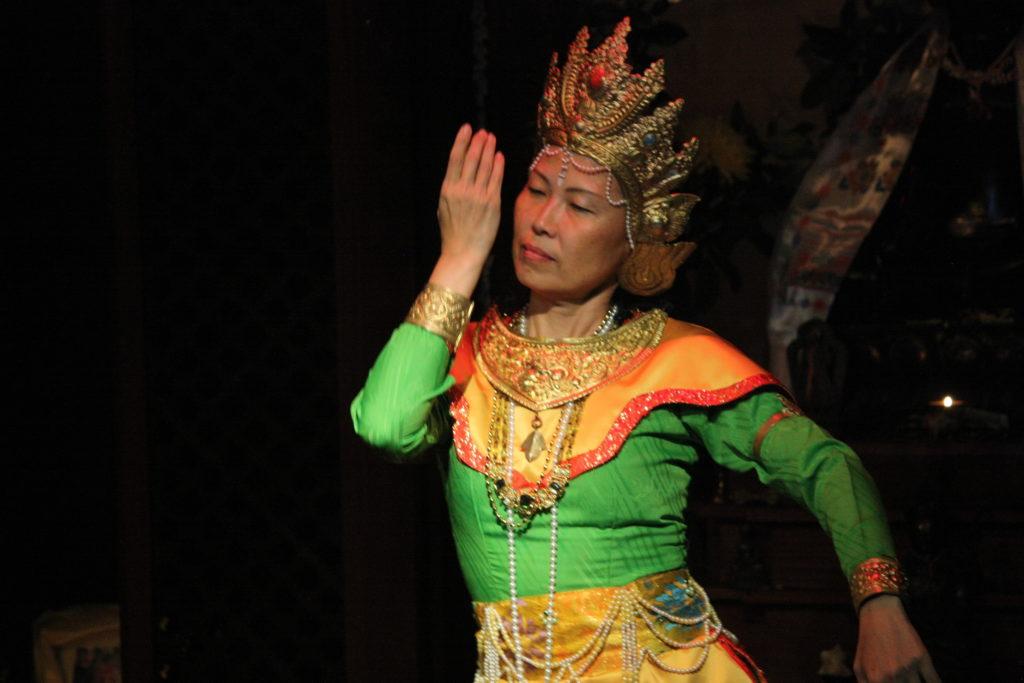
Key to the dances’ flowing energy is the integration of the tribhanga (triple bent) posture. As we assume this body stance (used in classical Indian dance and sculpture as well as in art depictions of many Buddhist deities), the torso slides away from its vertical central axis. One leg bears more weight than the other and we sink into the weight-bearing hip. The overall posture forms an “S” curve. As we move from one leg to the other in the basic four-count charya step, we shift the tribhanga pose from side to side. The resulting soft, undulatory motion evokes a sense of grace and benevolence. On a subtle body level, this movement naturally moves the three vertical channels and is said to cleanse obstructions to the flow of vital energy, or prana.
The costume ornaments provide another means to stimulate the chakras of the body with the six paramitas or perfections─again to promote the flow of compassion. The necklace is worn over the heart center to stir the first paramita of generosity. The earrings foster patience, bracelets and anklets encourage moral discipline, the belt rouses joyful effort, the crown promotes meditative concentration, and adorning the third eye awakens wisdom. Wearing (or imagining this) and contemplating the costume elements while dancing the movements and postures of the deity awakens sensory perception and fuels a shift into one’s divine nature. The dances are performed with the intention of transforming self as well as benefiting the viewer and all sentient beings through that transformation.
Before dancing Tara, we learned the charya dance of Avalokiteshvara, the bodhisattva of infinite compassion. With mudras, we portray ourselves as an ocean of serenity offering kindness to suffering beings, and we place Amitabha Buddha on the crown of our head. (Avalokiteshvara, the protégé or even a manifestation of Amitabha Buddha, is frequently rendered with Amitabha erupting from his crown.) The dances have an amazing way of bringing the iconography to life. As we go through the exercise of holding each of the deity’s postures for an entire minute, I feel the sensations and energy of those qualities restructuring my own body.
Prajwal began his formal charya instruction at the age of eight—learning alongside his older brothers and other vajracharya boys—from his father, the renowned Buddhist scholar and ritual master Ratna Kaji Vajracharya. For over a thousand years, the practice of charya nritya was restricted to members of the vajracharya lineage. The traditions were relegated to secrecy during the Rana dynasty (1846–1951) because of its repressive policies toward Buddhism as well as overall prohibitions on teaching and education enacted by the regime to control social dissent. The dances were only performed in the presence of small groups of patrons or other tantric initiates in private religious settings.

In a bold act in 1957, a charya dance was publicly performed at the World Buddhist Conference in Kathmandu. This spurred several of the active vajracharyas to finally take their cultural legacy public to secure its survival. Prajwal’s father began writing articles and teaching the practices in the 1970s─eventually producing a two-volume collection of about 560 charyas (songs and sadhana instructions). Heeding his father’s wishes, Prajwal has dedicated his life to bringing this unique Buddhist heritage from the temples of Nepal out into the world while maintaining its original purpose and meditative integrity. In the fall of 2022, Prajwal will lead a pilgrimage tour back to the Nepal Mandala for those who want to experience the sacred geography that nurtured these practices. Ironically, the Nepalese government has embraced this Buddhist dance tradition as the national classical dance and a secularized form is now taught at universities and staged at entertainment venues.
Although I originally traveled to the Portland vihara several years ago to learn the foundational charya practices from Prajwal, today because of COVID-19, there are now virtual opportunities available to the global community to study these practices. On Saturdays, I log on to Prajwal’s class, which he teaches from the temple’s calm, dimmed interior. He begins to lead us through the danced Prayer of Refuge. As I form the vajra mudra above my head, I can’t help but notice dazzling glints of sunlight dancing through the traditional Newar carved wooden windows. The ornate floral-patterned latticework was originally designed to allow the practitioners within to see out but deter those outside from seeing in. Today the shimmering natural light creates its own dance of radiance.
After learning the dances of Avalokiteshvara and Arya Tara, Prajwal asks, “Do you see the difference between the two?” The melody, lyrics, mudras, and structure of these two deity dances are quite similar. Dancing Avalokiteshvara, I feel my heart soften to the suffering of another as I mold my body into a physical expression of flowing compassion. With Tara, however, I jump out of my posture of steady grace and composure. Trembling with energy, I lunge and slice through the air, dispelling obstacles and fears as you would to protect an endangered child. “Do you see the difference between the two?” Prajwal repeats. After dancing the deities, my body assuredly knows.
See more
Nritya Mandala Mahavihara
Yangchenma Arts & Music
Related features from BDG
Charya Nritya: Ancient Buddhist Dances of Wisdom and Healing in the Modern World
Dance Survival
Dance as Knowledge, Part One





